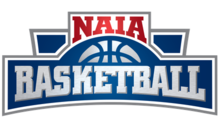NAIA men's basketball championship
College basketball tournament From Wikipedia, the free encyclopedia
College basketball tournament From Wikipedia, the free encyclopedia
The NAIA men's basketball national championship has been held annually by the National Association of Intercollegiate Athletics since 1937 to determine the national champion of men's college basketball among its members in the United States and Canada.
| Current season, competition or edition: | |
 | |
| Formerly | National college basketball tournament (1937–1981) |
|---|---|
| Sport | College basketball |
| Founded | 1937 |
| Founder | James Naismith |
| Motto | Passion. Tradition. History. |
| Divisions | 1 2 (1992–2020) |
| No. of teams | 64 (2022–present) 32 (1992–2020) 48 (2021) |
| Venue(s) | Municipal Auditorium (1937–1974, 2002–present) Kemper Arena (1975–1993) Mabee Center (1994–1998) Reynolds Center (1999) Tulsa Convention Center (2000–2001) Montgomery Fieldhouse (1992–1998) Idaho Center (1998–1999) Keeter Gymnasium (2000–2017) Sanford Pentagon (2018–2020) |
| Most recent champion(s) | Freed–Hardeman |
| Most titles | D-I: Oklahoma City (6) D-II: Bethel (IN), Cornerstone, Indiana Wesleyan, and Oregon Tech (3 each) |
| TV partner(s) | CBS College Sports Network (national) ESPN 3 (national) TWC Sports Channel (Kansas City area) Victory Sports Network (national) |
| Related competitions | NAIA women's basketball championship |
| Official website | naia.org/sports/mbkb |
The tournament was established by James Naismith to crown a national champion for smaller colleges and universities and has been held every year since, with the exceptions of 1944 (due to World War II) and 2020 (due to the COVID-19 pandemic).
Since 2022, the tournament has featured 64 teams, with teams beginning play at one of sixteen regional sites with the winners of those regionals playing at the final venue.[1][2]
From 1992 to 2020, the NAIA sponsored two championships, one for its Division I members and another for those in its Division II. The Division I tournament was played in Kansas City, Missouri while the Division II tournament moved locations several times (it finished, in 2020, at the Sanford Pentagon in Sioux Falls, South Dakota). During this time, the NAIA tournaments featured 32 teams with the entire events contested at one location in one week (rather than multiple locations over a series of weekends).
After the 2020 tournaments were cancelled, however, they were merged back into a single tournament, which initially featured 48 teams in 2021 before expanding to 64 teams in 2022.
All tournament games can be watched online through the official NAIA provider StretchInternet.[3]
The Men's Basketball Championship is mostly played at the Municipal Auditorium in Kansas City, Missouri.[4] It has been held in Kansas City every year since the tournament began except from 1994 to 2001, when it was played in Tulsa, Oklahoma, and in 2020, when no tournament was held. Kansas City will continue to host until at least 2024.
In 2018, the NAIA announced a new format for the 2021 tournament after the merger of D-I and D-II. Under the new format, the men's and women's tournaments each involve 64 teams (the first post-COVID tournaments in 2021 had 48 teams). The first two rounds are played at 16 separate sites, with only the 16 winners at these sites advancing to Kansas City.[5]
The tournament MVP has been presented with the Chuck Taylor Most Valuable Player award since 1939. In 1948, the NAIA became the first national organization to open their intercollegiate postseason to black student-athletes due primarily to the media attention surrounding the Manhatten Jaspers. Manhattan, who had an all-white team, learned of the NAIA rule that prohibited blacks from participating in the tournament, and after asking the NAIA to rescind the rule, the NAIA refused and Manhattan withdrew from the tournament. "The battle might have ended there but for a man named Harry Henshel, who was a member of the U.S. Olympic basketball committee. One of the reasons that the NAIA tournament was so prestigious was that the champion was invited to compete at the Olympic trials in New York City in late March. (The other teams invited were the two NCAA finalists, three teams from the Amateur Athletic Union, the winner of the National Invitation Tournament, and a YMCA team.)"[6] After reading in the New York papers that blacks could not participate in the tournament, Henshel suggested to the media that the NAIA national champion be eliminated from Olympic consideration. NAIA officials read Hershel’s statement in the papers and quickly took a telegraphic poll amongst its members the following day that rescinded the racial ban. In 1947, Coach John Wooden of Indiana State refused the invitation to the NAIA National Tournament primarily because Clarence J. Walker, the only black player on his team could not participate. Because of the stance taken by Manhattan and Harry Hansel, in 1948, Coach Wooden was able to take Walker to the tournament who became the first African-American student-athlete to play in the NAIA tournament. Walker, a vital role player, helped the Sycamores finish as the NAIA's national finalist. In 1957, Tennessee State became the first historically black college to win a national championship, and the first team to win three consecutive tournaments. As of 2017, Kentucky State is the only other school to do so (1970, 1971, 1972). Oklahoma City holds the record for the most tournament championships with six. OCU also holds the record for most national championship titles in NAIA women's basketball.
Seamless Wikipedia browsing. On steroids.
Every time you click a link to Wikipedia, Wiktionary or Wikiquote in your browser's search results, it will show the modern Wikiwand interface.
Wikiwand extension is a five stars, simple, with minimum permission required to keep your browsing private, safe and transparent.